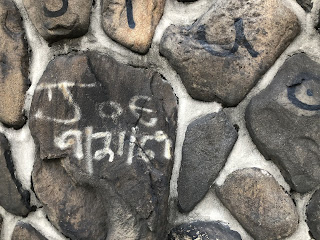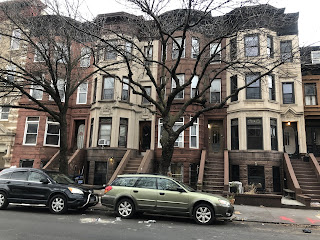Tuesday afternoon I took Negrosa, my vintage Mercian Olympic, for a spin along some landmarked blocks in central Brooklyn. I hadn’t planned to ride anywhere in particular; I just found myself spinning my pedals out that way.
Brooklyn has, probably, the greatest concentration—and some of the best examples—of brownstone houses. Long-since-gentrified (and bleached, if you know what I mean) neighborhoods like Park Slope and Carroll Gardens regularly (during non-pandemic times) witness throngs of architecture students and tourists savoring the details of those buildings. But some equally-beautiful areas like Stuyvesant Heights are less known because they are “off the beaten path. Stuyvesant Heights is still mainly an African- and Caribbean-American neighborhood. Hmm...Could that be a reason why tourists (or White New Yorkers, except for those in the know) don’t beat a path to it?
These houses on Decatur Street have details even more intricate than what I saw every day when I was living in “the Slope.”
I would love to see this neighborhood to keep the characteristics—including some interesting shops and cafes—that make it worth seeing. But I hope it doesn’t turn into a masoleum, I mean museum or, worse, a Brownstone Theme Park.
Likewise, I could see this railroad underpass—under which I passed on my way home—turning into what many of us hoped the High Line would become. The Montauk Cutoff, as it’s called, bears striking resemblances to The High Line before it became catwalk for the well-heeled high-heeled: Like the HL about 20 years ago, the MC is a weed-grown railroad right-of-way previously used by freight trains making deliveries to and from an old industrial area that’s starting to de-industrialize.
As I understand, the MC belongs to the Long Island Rail Road. (Yes, the LIRR still spells “Rail Road” as two words, just as they did in 1834!) Some reports say the Rail Road wants to add some trackage and connect it to their recently-expanded Sunnyside Yards. Others say it’s structurally unsound and will be torn down. Then there are stories that some city or state agency or investors want to acquire it and create a High Line, especially since some of the industrial sites could become upscale residential and commercial areas.
Me, I’d love for it to become a High Line for the people. It would include a bike lane (of course!), green spaces and art studios, galleries, craft shops, educational centers and cafes that could represent the many communities of Queens, the most culturally and linguistically diverse county in the United States, if not the world.
(Examples of the diversity include members of Central American indigenous groups who may or may not speak Spanish and Africans who might speak Wolof or some other native language and practice a religion far older than Christianity or Islam.)
Hmm...If someone takes me up on my idea, there might be a plaque or something with my name and likeness. Perhaps someone would look at it and wonder who, exactly, Justine was
just as I wonder what happened to Joe, or whether Marty and Janet stayed together. I mentioned these bits of graffiti on the Review Avenue wall of the Calvary Cemetery eight years ago. I first saw it many years ago—if I recall correctly, with my family, on our way to visit relatives who were living in Queens.
I never know what I’ll unearth on a ride!











No comments:
Post a Comment